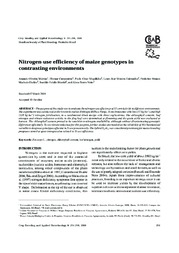Nitrogen-use efficiency of maize genotypes in contrasting environments.
Nitrogen-use efficiency of maize genotypes in contrasting environments.
Author(s): MARTINS, A. O.; CAMPOSTRINI, E.; MAGALHAES, P. C.; GUIMARAES, L. J. M.; DURAES, F. O. M.; MARRIEL, I. E.; NETTO, A. T.
Summary: The purpose ofthis study was to evaluate the nitrogen-use efficiency of 15 corn hybrids in different environments. The experiment was conducted at the research station Embrapa Milho e Sorgo, in environments with low (12 kg ha-l) and high (120 kg ha-J) nitrogen fertilization, in a randomized block design with three replications. The chlorophyll content, leaf nitrogen and nitrate reductase activity in the flag leaf were determined at flowering and the grain yield was evaluated at harvest. The chlorophyll content proved to be sensitive to nitrogen availability, although without discriminating genotypic differences efficiently. To use nitrate reductasefor this purposeJurther studies are needed on the reliability ofthis biochemical variable to diagnose genotypes efficient in N use precociously. The hybrid L2xL3 was considered promising for maize breeding programs aimed at gene introgression related to N-use efficiency.
Publication year: 2008
Types of publication: Journal article
Unit: Embrapa Maize & Sorghum
Keywords: Chlorophyll content, Leafnitrogen, Yield, Zea Mays, nitrogen
Observation
Some of Embrapa's publications are published as ePub files. To read them, use or download one of the following free software options to your computer or mobile device. Android: Google Play Books; IOS: iBooks; Windows and Linux: Calibre.
Access other publications
Access the Agricultural Research Database (BDPA) to consult Embrapa's full library collection and records.
Visit Embrapa Bookstore to purchase books and other publications sold by Embrapa.

